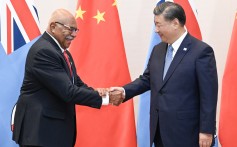China’s 10-year Belt and Road Initiative plan focuses on digital economy, information superhighways
- ‘Soft connectivity’ among aims listed in document outlining ‘visions and actions for ‘high quality belt and road cooperation’
- Focus will be on projects involving ‘small investment, quick results and good economic and social benefits’, plan released on Friday says
Priorities for the next 10 years would also include improving “soft connectivity” and reducing “hidden barriers” in goods and people-to-people exchanges, a document on the “visions and actions for high quality belt and road cooperation” released on Friday said.
“A number of landmark projects will be created that are highly praised by the countries where they are being built,” the plan read.
Officially announced by Xi in 2013, the now trillion-dollar belt and road strategy represents one of the world’s most ambitious infrastructure and investment programmes.
Originally devised to link China with Europe and the rest of Asia, the programme has gained steam in Africa, South America and the Pacific, as Chinese companies build roads, railways, ports and energy projects. This has significantly expanded China’s economic and political influence, especially in poorer countries desperate for better infrastructure to improve their economies.
However, the programme has also come under increasing scrutiny, especially as many of the projects faced runaway costs and allegations of debt-trap diplomacy, with Western nations voicing concerns over Beijing’s motives.
China also reportedly spent US$240 billion to bail out 22 developing countries between 2008 and 2021, with the amount soaring in recent years as several struggled to repay belt and road loans.
According to Friday’s vision document, infrastructure building to boost land and maritime connections, such as border facilities and seaports, will remain high on the agenda.
“China will work with all parties to build high-quality, sustainable, risk-resistant, affordable, inclusive and accessible infrastructure … so as to improve the overall connectivity of countries involved,” it said.
There will also be more projects related to digital connectivity, including “the construction of cross-border land cable and the submarine communications cables in order to broaden information exchange”.
After Australia, Fiji looks to China for help with port, shipyard project22 Nov 2023
Another priority will be digital governance, as China aims to speed up talks on digital transactions, including the Digital Economy Partnership Agreement (DEPA), the world’s first such trade agreement, and e-commerce negotiations under the World Trade Organization.
Meanwhile, China will step up efforts to promote global trade, sign more free trade agreements and expand agricultural cooperation with developing economies, in an effort to establish “secure, smooth and efficient food and farm product supply chains”.
It has also pledged to seek greater international financial cooperation, as well as promote the internationalisation of the Chinese yuan and its use in international financing.
Laura Zhou joined the Post's Beijing bureau in 2010. She covers China's diplomatic relations and has reported on topics such as Sino-US relations, China-India disputes, and reactions to the North Korea nuclear crisis, as well as other general news.






No comments:
Post a Comment